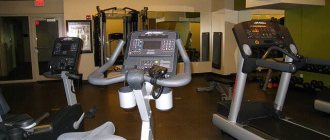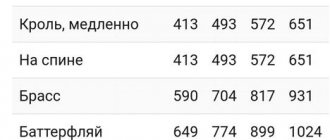When your goal is to lose weight, gain muscle, or improve athletic performance, consuming the right amount of calories is critical to progress. The number of calories you consume is influenced by a number of factors, including body weight, height, age and level of physical activity.
To calculate your daily calorie needs, you need to calculate how many calories your body expends when it is at rest, that is, not performing any activities. This will be a measure of your resting metabolic rate, or basal metabolic rate (BMR). Once you have a figure, you need to multiply your BMR by your activity factor, which will depend on your lifestyle and training requirements. Another indicator necessary when calculating total energy expenditure is the thermic effect of food. This is the energy needed to digest, transport and assimilate food. In this article, we'll take a closer look at each of these components, which will help you figure out how many calories you burn in a day.
This article will cover the following questions:
- How to calculate your BMR?
- How to calculate your activity level?
- Thermic effect of food
- How many calories do you burn per day?
- How many calories do you burn when exercising?
- How many calories does housework burn?
How many calories do you burn per day?
Women:
| Body weight (kg) | Sedentary lifestyle (kcal) | Moderate activity (kcal) | High activity (kcal) |
| 40 | 1430 | 1730 | 2040 |
| 50 | 1570 | 1900 | 2240 |
| 60 | 1700 | 2070 | 2440 |
| 70 | 1850 | 2240 | 2640 |
| 80 | 1990 | 2410 | 2840 |
| 90 | 2130 | 2580 | 3040 |
Men:
| Body weight (kg) | Passive lifestyle (kcal) | Moderate activity (kcal) | High activity (kcal) |
| 50 | 2000 | 2500 | 2950 |
| 60 | 2200 | 2680 | 3150 |
| 70 | 2340 | 2840 | 3350 |
| 80 | 2480 | 3000 | 3550 |
| 90 | 2620 | 3190 | 3750 |
| 100 | 2760 | 3360 | 3950 |
Lower limits of normal
The table can show how many kilocalories a person needs per day without taking into account individual characteristics that affect metabolism. By making a calculation using special formulas, you can find out your daily calorie intake. To the result obtained, add 200 kilocalories and then subtract 400.
These values are the upper and lower limits of normal. Another way to calculate this data is to subtract or add 10-15% of calories to your basal metabolic rate.
The range within these numbers is called the calorie corridor. This means that changes in daily caloric intake should not go beyond the normal range. Otherwise, the body will begin to slow down its metabolism and weight will stop losing, and energy will be extracted due to the destruction of muscle fibers.
How many calories are burned when doing exercise?
The number of calories burned in 20 minutes of exercise in people with different body weights:
| Exercise | Metabolic equivalent (MET) | 50 kg (kcal) | 60 kg (kcal) | 70 kg (kcal) | 80 kg (kcal) | 90 kg (kcal) |
| cycling, light exercise | 6,8 | 119 | 143 | 167 | 190 | 214 |
| cycling, moderate exercise | 8 | 140 | 168 | 196 | 224 | 252 |
| cycling, intense exercise | 10 | 175 | 210 | 245 | 280 | 315 |
| exercise bike, light load | 3,5 | 61 | 74 | 86 | 98 | 110 |
| exercise bike, light load | 6,8 | 119 | 143 | 167 | 190 | 214 |
| exercise bike, intense exercise | 8,8 | 154 | 185 | 216 | 246 | 277 |
| track, moderate load | 4,3 | 75 | 90 | 105 | 120 | 135 |
| track, intense load | 8 | 140 | 168 | 196 | 224 | 252 |
| cross training | 5 | 88 | 105 | 123 | 140 | 158 |
| resistance training | 5 | 88 | 105 | 123 | 140 | 158 |
| rowing, moderate load | 4,8 | 84 | 101 | 118 | 134 | 151 |
| rowing, intense exercise | 8,5 | 149 | 179 | 208 | 238 | 268 |
| running, 10 km/h | 9,8 | 172 | 206 | 240 | 274 | 309 |
| running, 11 km/h | 11,5 | 201 | 242 | 282 | 322 | 362 |
| running, 13 km/h | 11,8 | 207 | 248 | 289 | 330 | 372 |
| walking, 3 km/hour | 3 | 53 | 63 | 74 | 84 | 95 |
| walking, 6 km/hour | 5 | 88 | 105 | 123 | 140 | 158 |
| walking, 8 km/h | 8,3 | 145 | 174 | 203 | 232 | 261 |
Standards for women, men and children
The table can show how many kilocalories a person needs per day more clearly. It is worth taking into account that physical activity requires replenishment of additional energy expended during training. In addition, more calories are spent on daily muscle maintenance.
| Group of persons | Need to consume calories per day |
| Children 6 months–3 years | 800–1500 |
| Children 3–11 years old | 1500–2500 |
| Girls and boys 14–17 years old | 2700–3100 |
| Pregnant and lactating women | 3200–3500 |
| Athletes women and men | 4000–5000 |
Using the table above, you can determine with sufficient accuracy how many kilocalories a person needs per day, taking into account his age, gender and physical activity.
This difference between certain groups of people is justified by different physical activities. In addition, pregnant and lactating girls need to increase their diet in order to additionally provide the child with the necessary compounds, as well as replenish the resources expended on this.
The amount of calories in women is slightly less than in men. Age and work environment also affect the amount of energy expended:
| Women age in years/calorie norm | Men age in years / calorie intake | ||||
| 21–26 | 27–50 | >50 | 21–26 | 27–50 | > 50 |
| 1900 | 1700 | 1600 | 2400 | 2100 | 1800 |
The calorie intake is determined by many factors, as well as the BZHU ratio. To calculate them more accurately, you need to use one of the special formulas. And based on the results obtained, you can subsequently adjust your calorie intake.
Don't miss the most popular article in the section: Fashionable haircut for short hair. Photo, front and back views.
How many calories does housework burn?
The number of calories burned in 20 minutes of activity in people of different body weights:
| Exercise | Metabolic equivalent (MET) | 50 kg (kcal) | 60 kg (kcal) | 70 kg (kcal) | 80 kg (kcal) | 90 kg (kcal) |
| work on computer | 1,5 | 26 | 32 | 37 | 42 | 47 |
| hold working meetings | 1,3 | 23 | 27 | 32 | 36 | 41 |
| watching TV | 1 | 18 | 21 | 25 | 28 | 32 |
| do the cleaning | 3,3 | 58 | 69 | 81 | 92 | 104 |
| vacuum | 3,3 | 58 | 69 | 81 | 92 | 104 |
| Cook food | 2,5 | 44 | 53 | 61 | 70 | 79 |
| sit | 1,3 | 23 | 27 | 32 | 36 | 41 |
| mow the lawn | 5,5 | 96 | 116 | 135 | 154 | 173 |
| dream | 0,95 | 17 | 20 | 23 | 27 | 30 |
Conclusion
Energy expenditure depends on three main factors: basal metabolism, level of physical activity and the thermic effect of food. Without the use of expensive laboratory equipment, it can be difficult to accurately calculate the exact number of calories burned because there are a number of factors that affect the accuracy of the estimate.
The above equations will help you get a rough idea of how many calories you need. One thing to keep in mind is that the biggest variable is the degree of physical activity, which is different for everyone.
Articles on our website are presented for educational and informational purposes only. We do not recommend using article materials as medical advice. If you decide to take dietary supplements or make fundamental changes to your diet, first consult with a specialist.
Translation: Farida Seidova
Did you like the article? We have selected similar articles for you:
Healthy Eating
How to speed up your metabolism? I 15 tips
How to start progressing and speed up your metabolism? Certain habits will help you burn more calories.
2021-06-11 14:00:57 • Claire Muszalski
Healthy Eating
How to burn fat quickly? I Tips and tricks
How to lose weight and reduce body fat? What percentage of body fat is considered normal and how to calculate it?
2021-08-15 18:00:36 • Claire Muszalski
Healthy Eating
What are kilocalories and BZHU, their main tasks
A kilocalorie measures the amount of heat released from foods during digestion. One calorie is equal to 4.2 joules - a characteristic of energy level. The body spends this component to maintain vital functions.
One unit of heat gives the same amount of energy. Products differ in the ratio of BJUs, and the digestion of each of these components requires a different amount of energy. Therefore, the part of the heat that the body loses when breaking down food is taken away from the initial calorie content.
The body consumes each element of BJU in its own way:
- Carbohydrates provide 4 kcal. Once in the metabolism, they are converted into glucose and raise blood sugar levels, which gives the body energy to work. Most of this resource is extracted from food and consumed immediately. The body stores the remainder as fat.
- Proteins provide 4 kcal and are broken down into amino acids, which act as builders of tissue and muscles, and also deliver oxygen to cells. The body creates some of the components of this substance on its own. The body does not store protein and receives it only from food; the remains are eliminated naturally.
- Fats provide 9 kcal, are used to protect organs, obtain energy and other body functions. The body constantly stores lipids and spends these reserves last.
The table with dietary volumes shows approximately how many kilocalories a person needs per day, but does not take into account the energy value of food. In order for the energy received by the body to be spent correctly, it is worth adhering to the KBZHU.
Calorie content or balance of BZHU: what is more important:
Endomorphs
Endomorphs have wide bones. Such people are predisposed to be overweight. To the deep regret of most endomorphs, even squats, jogging and cardio exercises often yield little weight loss results. The endomorph body is prone to the accumulation of adipose tissue.
When calculating the body’s energy expenditure using a kcal calculator, it is necessary to take into account the characteristics of physical activity and the foods consumed. It is better for such people to eat a balanced diet, and best of all, a low-carbohydrate diet.
Ectomorphs
Ectomorphs rarely worry about determining the calorie content of dishes, since owners of this body type tend to be thin. Ectomorphs have above average height and meager fat reserves: at the same time, muscle relief is clearly visible. The calculator is often used for the purpose of gaining weight and strength training.
Often, ectomorphs go to training not with the goal of losing weight, but with the desire to gain muscle mass. Even for this, calculations on a calculator are simply necessary. Ectomorphs often face envy from other body types due to the following features:
- Ability to withstand intense loads for a long time;
- Fast fat burning;
- Accelerated metabolism;
- Even a small loss of calories and eating fatty foods often does not help a person gain weight.
Carbohydrates and kcal are burned in the ectomorph’s body very quickly, and instead of fat deposits, thinness is noted.
Formula based on body area
Another name for this method of calculating calories is the Harris-Benedict formula. With the help of such calculations, you can obtain a result as close to reality as possible. The expression contains weight, height and age, and for women and men different initial numbers are used in the calculations.
The percentage of body fat does not appear in the calculations. Therefore, this method will not show accurate results for people who exercise regularly and have large muscle mass. In this case, the basal metabolic rate will be lower than the real one. For overweight people this value will be overestimated.
For men, the daily calorie intake is calculated using the formula:
GV = 66 + (13.699 * weight in kg) + (5 * height in cm) - (6.809 * age in years).
And for women:
GV = 65 + (9.599 * weight in kg) + (1.799 * height in cm) - (4.8 * age in years).
The daily caloric intake coefficient for a man with indicators of 70 kg, 170 cm, 27 years old is:
OOV = 66 + (13.699 * 70) + (5 * 170) - (6.809 * 27) = 1691 kcal.
For a woman with initial data of 23 years old, weight 50 kg, height 165 cm, this figure is equal to:
OOV = 65 + (9.599 * 50) + (5 * 165) - (6.809 * 23) = 1213 kcal.
In addition, the result obtained can be multiplied by the indicator of physical activity. A range is proposed for him, in which 1.2 is low mobility, 1.729 is heavy physical work.
Harris-Benedict formula
The formula, which is widely used for calculations, was invented in 1991. However, the method is inferior in applicability to other methods. Compared to other formulas, an insufficient number of individual characteristics are used here, which gives a strong error in the calculations - more than 5%. The method does not take into account the indicator of daily physical activity in the calculations.
The formula looks like this:
Female: 655 + (9.5 * weight in kg) + (1.86 * height in cm) – (4.67 * age).
Male: 66.48 + (13.74 * weight in kg) + (5 * height in cm) – (6.75 * age).
Thus, a woman with indicators of 50 kg, 23 years old, 165 cm will need to consume 1332 kcal. A man with initial data of 70 kg, 26 years old, 180 cm needs 1703 kcal to remain at his weight.
Weight loss rate
Losing weight by 2-3% of your current weight per week is considered safe by nutritionists. With large mass losses, the body will begin to destroy itself and extract energy from these substances. The largest drop is observed at the beginning of the diet; subsequently, its loss slows down.
It is important to understand that supplementing nutrition with active physical activity can cause weight loss. This is due to the accumulation of fluid in the muscles, as well as their growth. In this case, you need to observe a visual decrease in volume.
Weight gain rate
There is a difference between intentional weight gain and uncontrolled eating. In the first case, this process is systemic and is used both for visual effect and as an introductory step in the method of calorie counting. In these cases, muscle mass gain will occur much more slowly.
If there are sharp deviations from the caloric norm in the direction of increase, reserve fat will be deposited almost instantly.
However, with a gradual increase in the volume of the diet to your own norm in increments of 50 kcal weekly, weight gain will not be observed at all.
This is due to the fact that the body gradually adapts its work to the new diet. However, with a calorie deficit, a sharp transition to a new nutrition system will lead to extra pounds.
Don't miss the most popular article in the section: Fashionable bangs of the new season for medium, short, long hair. Photo.
How to Improve Your Walking Efficiency
To achieve better results while walking, use the advice of experts:
- master Nordic walking with poles;
- add small ankle weights;
- try to walk more on mountainous terrain or stairs;
- walk part of the way at a faster pace;
- gradually increase the distance;
- combine walking with exercise on sports grounds.
Get into the habit of taking daily walks and you will understand how useful and exciting this activity is. You will be able to better explore the surrounding nature and visit new places. But you will also spend time with health benefits.
Regular walking helps not only to get rid of extra pounds. You will improve your health, strengthen your joints and muscles, normalize blood pressure, calm your nerves and improve your mood.
Consequences of insufficient and excess calorie intake
At first, insufficient or excessive calorie intake may not be noticeable.
However, this lifestyle systematically harms the body, which is why the accumulated habit can lead to the following negative consequences:
- decreased immunity;
- eating disorders, such as compulsive overeating;
- disturbances in the gastrointestinal tract;
- oncology;
- disorders in mental and physical development.
In addition to the lack of calories in the diet, their excess gives rise to a lot of problems leading to obesity and accompanying diseases:
- diabetes;
- diseases of the cardiovascular system;
- atherosclerosis;
- disorders in the musculoskeletal system.
It should be understood that the calorie rate for one person may be too high or low for another. Only the volume of reserve fat can tell whether the diet is correct.
Is there accurate data?
Determining how many calories a person burns per day can only be done through individual testing, since there are no single general indicators that are suitable for everyone. So, we have already found out that energy consumption is individual for each person. But how to calculate how many calories a person should burn per day? To do this you need to turn to statistical data.











